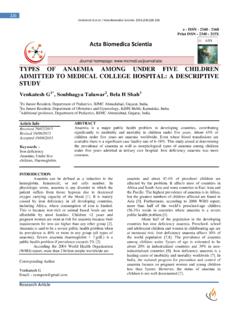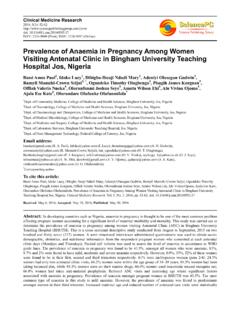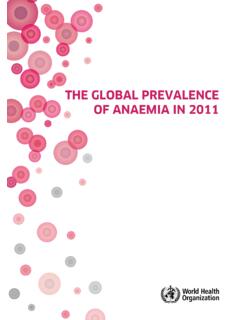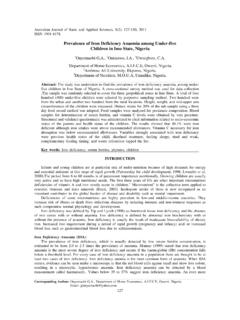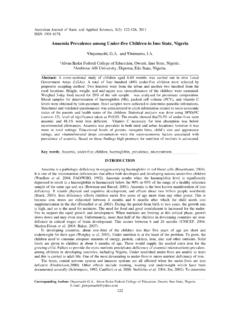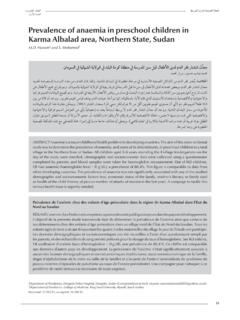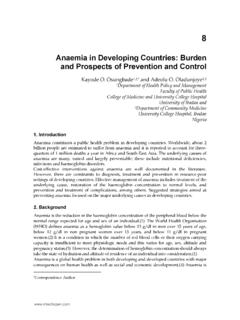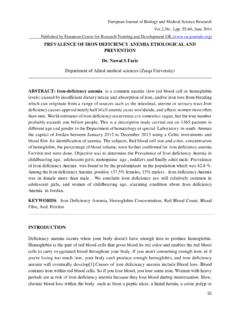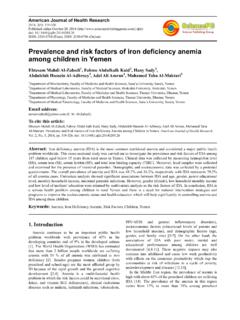Transcription of Prevalence of Iron Deficiency Anaemia in Children ...
1 IOSR Journal of Dental and Medical Sciences (IOSR-JDMS) e-ISSN: 2279-0853, p-ISSN: 15, Issue 8 Ver. IV (August. 2016), PP 28-32 DOI: 28 | Page Prevalence of Iron Deficiency Anaemia in Children Attending ICDS Center in a Tier II City MD (Paed)1, . Professor, Department of Paediatrics Coimbatore Medical College Hospital, Coimbatore Abstract: Introduction: Anemia is known to be a significant global problem affecting 305 million School Aged Prevalance of anemia according to National Family Health Survey (NFHS-3) reveals 70-80% in And developing countries, Prevalence rates of to have been reported, with in South East Asia. Estimation of Prevalence of anemia is helpful only if they are associated with determination of causative factors that contribute to the development of anemia. Though anemia is an important public health problem, there are numerous countries which lack national Prevalence data.
2 Most survey includes mainly: preschool age Children , non pregnant women of reproductive age and pregnant women .2 An increased Prevalence rate in school aged Children reflects inadequate nutritional iron intake, generalised malnutrition or low iron bioavailability of diet. The consequences of iron Deficiency are many and seriously affect not only individuals' health but also development of societies and , 4 In order to know the Prevalence of iron Deficiency anemia among young Children , this study included Children from 30 ICDS centres. This study concentrated on the risk factors for anemia in the family and social level, which may help in reducing the Prevalence of iron Deficiency anemia at the community level & thus percentage of the morbidities due to iron Deficiency in growing Children . Objective: To Determine the Prevalence , risk factors and associated common deficiencies of iron Deficiency anemia among 2-5 yr Children attending ICDS centres and to know the knowledge & practice by their mothers regarding iron Deficiency anemia prevention Design: cross-sectional observational study.
3 Setting& Participants: Total of 732 Children in 30 ICDS Centers around the Peelamedu region in Coimbatore during October 2014 to September 2015. Method: Detailed history obtained using specific questionnaire in typed format and complete physical examination was done in all. Hematocrit, MCV, MCH, RDW, peripheral smear and reticulocyte count done in all Children whereas , TIBC done for confirmation of iron Deficiency anemia within 3 days duration. Results: Prevalence of anemia among Children of ICDS centers of Coimbatore from the present study is From the present study, the Prevalence of clinical pallor is found to be 16%(117) among which 12%(89) are anemic. Intiation of cow s milk earlier is a important risk factor for development of anemia contributing to 24% population. Among the group who gives history of passing worms in stools 30% are in anemic group and are in non anemic group.
4 ODDS Ratio comes around and relative risk comes around times. Conclusion: The overall Prevalence of anemia in our study was less as compared to other Studies which could be attributed to regular deworming and Iron and Folic acid supplementation by the Health Authorities since 2003 and effective functioning of Mid Day Meal programme. Additionally, a diet rich in Vitamin A should be supplemented. Keywords: Iron Deficiency Anaemia , ICDS centers, risk factors. I. Methodology 30 ICDS centers around peelamedu region are selected and prior information regarding the visit is informed 2 weeks before. After getting consent from parents, detailed history is obtained using specific questionnaire in typed format and complete physical examination was done in all. Socio-economic status classified based on Modified Kuppusamy scale. Children in 2-5 years age group are clinically examined for signs of iron Deficiency anemia and other Vitamin deficiencies.
5 Anthropometry readings are entered. Height was measured by wall mounted fiber glass tape and weight was measured with mechanical weighing scale and BMI was calculated. BMI was categorized as low when it was less than 14 for 2-3 year age group and less than 15 for 3-5 year age group. Two different Growth charts for Male and Female separately were used. Prevalence Of Iron Deficiency Anemia In Children Attending Icds Center In A Ii Tier City DOI: 29 | Page Around 3ml of blood is drawn in EDTA sample tube using disposable syringe from all the Children to determine hemoglobin, Hematocrit, MCV, MCH, RDW peripheral smear and reticulocyte count. From those Children , who are found to be clinically pale, another 3ml of blood is drawn and , TIBC done for confirmation of iron Deficiency anemia within 3 days duration. Hemogobin, MCV, MCH, RDW are determined by using Sysmex KX-21 auto analyzer.
6 And TIBC are done by Chemiluminisence immune assay. The blood cell counting is based on the impedance principle with both the cell counts and histograms obtained through the analysis of blood cell dilution. It employs three detector blocks and two kinds of reagents for blood analysis. The WBC detector using DC detection method, measures WBC count. The RBC and platelet counts are measured by RBC detector blocks and it also employs the DC detection method. The HGB detector block measures the hemoglobin concentration by using the non-cyanide method. Ideal, tongue shaped peripheral smears were prepared on clean glass slides and stained with Leishman's stain using the following standard procedure. When the slides were dry, they were examined under oil immersion lens. The number of RBCs and the reticulocytes were counted in 10 to 15 fields. The data was entered in excel data sheet and the chi square test was used assess differences in categoric variables between groups.
7 Comparsion between groups was made by the Non parameteric Wilcoxon Rank test. Odds ratio and Relative Risk were determined. A p value of < using a two-tailed test was taken as being of significance for all statistical tests. All data were analysed with a statistical software package. (SPSS, version for windows) II. Results The present study was undertaken to know the Prevalence of anemia in ICDS Children and to know the influence of factors like sex, socioeconomic status and diet as a causative factor for anemia. This is a cross sectional observational study conducted from Oct 2013 to Sep 2014. Total of 732 Children in 30 ICDS Centers around the Peelamedu region in Coimbatore were studied. These Children were given Iron and Folic acid supplementation by Ministry of Health and Family Welfare. Children aged 2-5 years received 30 mg elemental iron and 250 mcg folic acid daily for 100 days a year. Biannual deworming was done in all. All Children were provided with mid day meal which provided 1/3rd of the total calorie requirement and of the total protein requirement.
8 From the study population of 732, clinical pallor was present in (16%)117 members of which(12%) 89 members are anemic (Table:1). From the present study, among the pallor group 31% (36) are moderately anemic and 45% (53) of are mild anemic and 24% (28) have normal hemogliobin. And 100 %( 615) of No-Pallor group have normal hemoglobin. Prevalence of anemia among Children of ICDS centers of Coimbatore from the present study is The Prevalence of Anaemia in our study was almost similar to that in study by Mutthayya et al5. WHO study has included Children worldwide where Prevalence was (Table: 2). In the study by Djokic et al3, most of Children studied were non vegetarians. In our study there was improvement in Prevalence rate , similar to study by S Mutthayya et al. The reason for this low Prevalence would be the regular deworming and Iron and Folic acid supplementation by the School Authorities since 2003.
9 In combination with these interventions, the consumption of a simple rice-based lunch supplying roughly 300-400 kcal/day may not only improve the overall nutritional status of school aged Children , but also contribute a small amount of iron each ,7 43% of male (38/89) are found be anemic and 57% of females (51/89) are found be anemic. Anemia is equally distributed in male and female Children . There was no significant difference between Prevalence of anemia in males and females in our study which can be attributed to the improvement in nutritional status of females because of provision of meal at school without any partiality. Of the total population of lower SES 29% (26/89) are in anemic group and (13/643) Non-anemic group and in upper lower SES 58% (51/89) are in anemic Group and (67/643) % are Non-anemic group and in lower middle SES 14% (12/89) are anemic group and (563/643) are Non-anemic group. So anemia occupies a large population of lower SES9.
10 In both the studies, Prevalence of Anaemia was more in upper lower (class IV) SES as the total number of Children in upper lower SES in our study was more. Among the population, who initiates cow s milk earlier before 6 months of age 73% (65) are in pallor group and 6% (39) are no-pallor group. So intiation of cow s milk earlier is a important risk factor for development of anemia contributing to 24% population8. Of the population who consumes non-veg monthly once 33%(31) are among anemic group and (16) are Non- anemic group and among those who consume Bi-weekly 48% (43)are among anemic group and (60)are in Non anemic group and in those who consume weekly 17%(15) are in anemic group and (567) are in Non anemic group. So population who are on monthly/biweekly non veg diet are more affected by anemia than those with who take weekly. Prevalence Of Iron Deficiency Anemia In Children Attending Icds Center In A Ii Tier City DOI: 30 | Page Among the group who gives history of passing worms in stools 30% are in anemic group and are in non anemic group and among those who have no such history 70% are in anemic group and are in Non- anemic group with P value of < ODDS Ratio comes around and relative risk comes around times.










